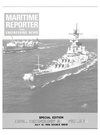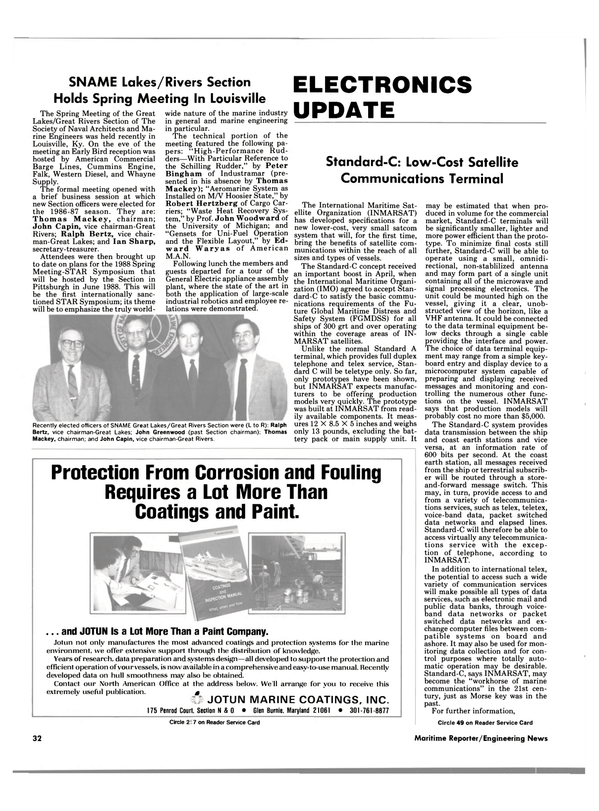
S t a n d a r d - C : Low-Cost Satellite Communications Terminal
The International Maritime Satellite Organization (INMARSAT) has developed specifications for a new lower-cost, very small satcom system that will, for the first time, bring the benefits of satellite communications within the reach of all sizes and types of vessels.
The Standard-C concept received an important boost in April, when the International Maritime Organization (IMO) agreed to accept Standard- C to satisfy the basic communications requirements of the Future Global Maritime Distress and Safety System (FGMDSS) for all ships of 300 grt and over operating within the coverage areas of INMARSAT satellites.
Unlike the normal Standard A terminal, which provides full duplex telephone and telex service, Standard C will be teletype only. So far, only prototypes have been shown, but INMARSAT expects manufacturers to be offering production models very quickly. The prototype was built at INMARSAT from readily available components. It measures 12 X 8.5 X 5 inches and weighs only 13 pounds, excluding the battery pack or main supply unit. It may be estimated that when produced in volume for the commercial market, Standard-C terminals will be significantly smaller, lighter and more power efficient than the prototype.
To minimize final costs still further, Standard-C will be able to operate using a small, omnidirectional, non-stablilized antenna and may form part of a single unit containing all of the microwave and signal processing electronics. The unit could be mounted high on the vessel, giving it a clear, unobstructed view of the horizon, like a VHF antenna. It could be connected to the data terminal equipment below decks through a single cable providing the interface and power.
The choice of data terminal equipment may range from a simple keyboard entry and display device to a microcomputer system capable of preparing and displaying received messages and monitoring and controlling the numerous other functions on the vessel. INMARSAT says that production models will probably cost no more than $5,000.
The Standard-C system provides data transmission between the ship and coast earth stations and vice versa, at an information rate of 600 bits per second. At the coast earth station, all messages received from the ship or terrestrial subscriber will be routed through a storeand- forward message switch. This may, in turn, provide access to and from a variety of telecommunications services, such as telex, teletex, voice-band data, packet switched data networks and elapsed lines.
Standard-C will therefore be able to access virtually any telecommunications service with the exception of telephone, according to INMARSAT.
In addition to international telex, the potential to access such a wide variety of communication services will make possible all types of data services, such as electronic mail and public data banks, through voiceband data networks or packet switched data networks and exchange computer files between compatible systems on board and ashore. It may also be used for monitoring data collection and for control purposes where totally automatic operation may be desirable.
Standard-C, says INMARSAT, may become the "workhorse of marine communications" in the 21st century, just as Morse key was in the past.
For further information, C i r c l e 4 9 on Reader S e r v i c e Card
Read S t a n d a r d - C : Low-Cost Satellite Communications Terminal in Pdf, Flash or Html5 edition of July 15, 1986 Maritime Reporter
Other stories from July 15, 1986 issue
Content
- FlightSafety Orders Shiphandling Simulator From Tracor Hydronautics page: 4
- Valmet And Wtirtsilti To Merge Shipbuilding Operations In One Group page: 5
- Dillingham Restructures West Coast Operations— Key Executives Named page: 5
- Falmouth Shiprepair Moves Ahead Again With Major N e w Agreement page: 6
- Nippon Kokan To Market Titanium-Clad Steel Plate Produced By Hot Rolling page: 6
- Freeport Shipbuilding Delivers Passenger Vessel To Nassau Cruises page: 7
- Franklin Promoted To Vice President At McDermott Marine page: 7
- U.S. NAVY SHIP MAINTENANCE AND MODERNIZATION page: 8
- MAJOR NAVY CONTRACTS page: 11
- DIESEL POWER REVIEW page: 18
- M e y e r W e r f t Y a r d Delivers Luxury Cruise Ship ' H o m e r i c ' To H o m e Lines page: 30
- Coast M a r i n e Celebrates 4 0 - Y e a r A n n i v e r s a r y W i th Successful Ladder Drop Test page: 30
- Bailey Announces Sales Management Appointments page: 31
- Free Brochure Details Delaval's OEM Overhaul Of U.S. Navy Equipment page: 31
- S N A M E Lakes/Rivers Section Holds Spring M e e t i n g In Louisville page: 32
- S t a n d a r d - C : Low-Cost Satellite Communications Terminal page: 32
- Port Of Portland Reports Soaring Imports Of Cars From Japan And Korea page: 34
- Miller Electric Offers New Diesel Welding Generator page: 34
- S.S. White Offers Free Brochure On Flexible Reach Rods page: 35
- NASSCO Appoints Janice S. Shanklin page: 35
- Lorenz, Trotter And Waldorf Named To Zapata Board Of Directors page: 35
- Sea-Land Unit Restructured — B a k e r Appointed Vice Chairman And COO page: 36
- Goltens Uses Diversity To Seek New Markets page: 36
- ACBL Rechristens Three N e w l y Acquired River Towboats page: 36
- Marathon LeTourneau Awarded Contract For Platform Rig Project page: 36
- MTCR Introduces N e w Shipboard E n g i n e e r i n g T r a i n i n g Systems page: 37
- Sanborn Named President Of Sonat Marine Inc. page: 38
- Sperry Introduces A d v a n c ed S a t e l l i t e Communicators page: 38
- W a r t s i l a Diesel Introduces A N e w Compact V 8 Engine page: 39
- Sembawang Diversifies Into Salvage And Towing page: 39
- Cat Pumps Introduces Corrosion-Resistant Line page: 39
- Report O n The N e w M a g n a v ox GPS Positioning & N a v i g a t i o n System page: 40
- Tenn-Tom Development Conference Scheduled For October 22-24 In Knoxville page: 40
- Pekka Laine Appointed Managing Director Of New Wartsila/Valmet Company page: 40
- Combustion Engineering A w a r d ed $ 7 M i l l i o n In N a v y Boiler Contracts page: 41
- Improved TV Antenna From Naval Electronics page: 41
- Marathon LeTourneau Awarded Contract For Platform Rig Project page: 41
- Honda Will Use U.S.-Flag Central Gulf Lines Ship To Transport Cars To U.S. page: 41
- 9.7-Million Contract Awarded Bender For USS Pensacola Overhaul page: 41
- Motor Insulation System M e e t s N a v y Specifications page: 42
- MSC To Procure Additional Ships For Ready Reserve Force page: 42
- Phillips Reassigns Three In Supply, Transportation page: 43
- Radio H o l l a n d USA Announces N ew T h r a n e & Thrane Radiotelex Unit page: 43
- Nicor Installs Advanced Management System Aboard Supply Boat page: 43
- Grctndi Motori A l r e a d y Has Orders For Its N e w Long-Stroke M e d i u m - S p e e d Diesel page: 44
- National AirOil Introduces Portable Burner Ignitor page: 45
- Royal Caribbean Orders Three More Vessels page: 45
- M A R I N E LUBRICANTS MEETING T H E D E M A N D S OF N EW A N D U P G R A D E D DIESELS page: 46
- ANADAC Awarded Navy Support Services Contracts Totaling $4 Million page: 49
- N e w Rental Program For M a g n a v o x Equipment O f f e r s W i d e Selection page: 49
- Allison I m p l e m e n t s Performance, M a i n t e n a n c e , Reliability Improvements In M a r i n e Gas Turbines page: 50
- Free 12-Page Brochure On MARPAC Ball Valves From Mark Controls page: 51
- Integrated Ship Electronic Systems page: 52
- COMAR Offers Free Catalog On N e w Marine Products page: 53
- Powell Appointed Executive VP And General Manager, Bay Shipbuilding Corp page: 53
- Unaflex Introduces New Molded Expansion Joints page: 53
- Caterpillar Tractor Co. Renamed Caterpillar Inc. page: 53
- Russellstoll Offers Plugs, Receptacles And Connectors For Cord S e t s page: 54
- Action Threaded Products Offers 20-Page Color Brochure On Non-Corrosive Fasteners page: 54
- Valmet Automation Gets Order For Eight Damatic Systems From Yugoslavia page: 55
- Coastal States Trading Announces Personnel Changes page: 58
- Bailey Offers Custom Computer-Designed Refrigeration page: 58
- Gould Opens N e w Facilities For Circuit Breaker Repair, Overhaul page: 58
- MacGregor-Navire Access Gear Ordered For Vehicle Carriers Building In People's Republic page: 58
- Marine Travelift Hoists Now Feature Four-Wheel Drive page: 61
- Rockwell-Collins Awarded Contract To Supply Data Links For Spanish Navy page: 62
- American Ship Building To Enter Hawaiian Cruise Ship Trade page: 62
- First I n t e r n a t i o n a l Conference On Ice Technology Held At M IT page: 67
- Verolme To Build Two Corvettes For $50 Million For Brazilian Navy page: 67


